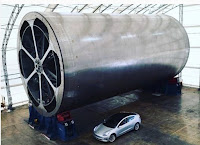
 Space has always been a source of
intrigue and fear. Space is humanities last great unknown. Space is a point of
infatuation for present day entertainment media. Black Mirror and Cosmos are
just two examples of shows that entirely revolve around space and technology.
While space is infused in modern artwork, there is also a level of artistry to
the engineering that goes into exploring space. Take for example the work of
Elon Musk. His company, SpaceX, is currently working on creating the first
passenger spaceships capable of flying to mars. The team has found ways to
hollow portions of the 157 foot body piece to keep the crafts weight low.
Preparation for launch also requires artistic precision. Astronomers and scientists
work tirelessly to determine the exact time to launch to catch gravitational
orbits and “slingshot” the rocket. This method will be vital in creating ships
that can reach planets as far as mars or even beyond in a reasonable amount of
time.
Space has always been a source of
intrigue and fear. Space is humanities last great unknown. Space is a point of
infatuation for present day entertainment media. Black Mirror and Cosmos are
just two examples of shows that entirely revolve around space and technology.
While space is infused in modern artwork, there is also a level of artistry to
the engineering that goes into exploring space. Take for example the work of
Elon Musk. His company, SpaceX, is currently working on creating the first
passenger spaceships capable of flying to mars. The team has found ways to
hollow portions of the 157 foot body piece to keep the crafts weight low.
Preparation for launch also requires artistic precision. Astronomers and scientists
work tirelessly to determine the exact time to launch to catch gravitational
orbits and “slingshot” the rocket. This method will be vital in creating ships
that can reach planets as far as mars or even beyond in a reasonable amount of
time. The way
space has permeated pop culture has made it very interesting to see the
disparities between artistic interpretations of future technologies and the
actual progression of those technologies. Surprisingly, many predictions of
space and the technologies that will propel us there. One example is Konstantin
Tsiolkovsky who predicted societies ability to leave Earth’s orbit long before
it was a scientific possibility. He also predicted the “overview effect” which
increases astronauts global awareness after seeing Earth from space.
The way
space has permeated pop culture has made it very interesting to see the
disparities between artistic interpretations of future technologies and the
actual progression of those technologies. Surprisingly, many predictions of
space and the technologies that will propel us there. One example is Konstantin
Tsiolkovsky who predicted societies ability to leave Earth’s orbit long before
it was a scientific possibility. He also predicted the “overview effect” which
increases astronauts global awareness after seeing Earth from space.
References
Amos, Jonathan. “Elon Musk's Falcon Heavy Rocket Launches Successfully.” BBC News, BBC, 7 Feb. 2018.
“Getting Rockets into Space.” Science Learning Hub.
Gorman, Alice. “Looking up a Century Ago, a Vision of the Future of Space Exploration.” The Conversation, The Conversation, 5 June 2018.
“Gravitational Slingshot.” Huygens' Principle.
Wall, Mike. “Elon Musk Shows Off 'Tool' for Mars-Colonizing Spaceship (Photo).” Space.com, Space.com, 9 Apr. 2018.
No comments:
Post a Comment